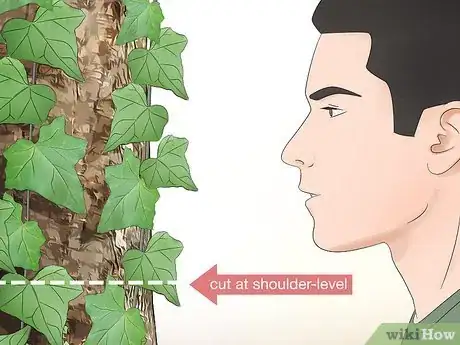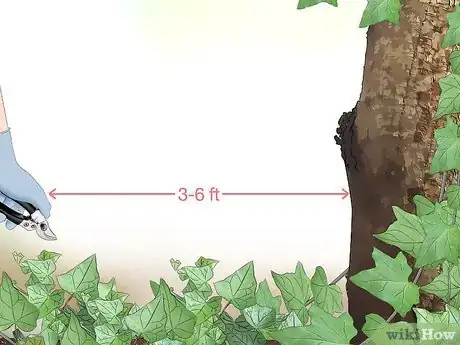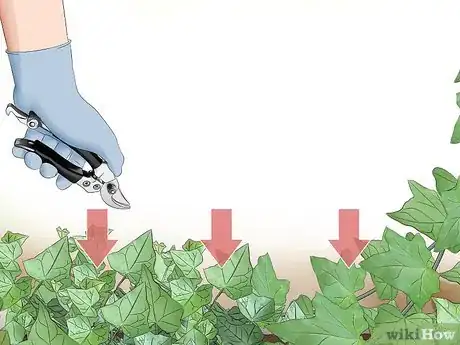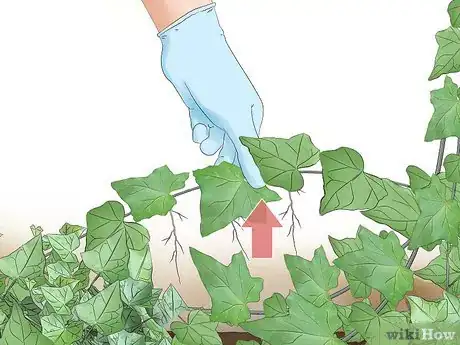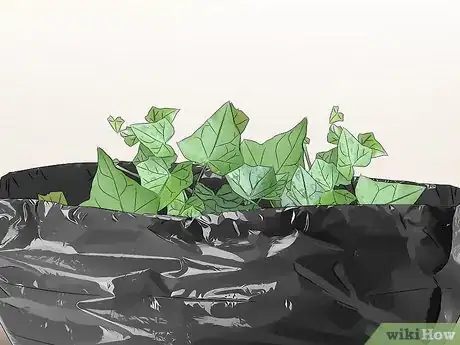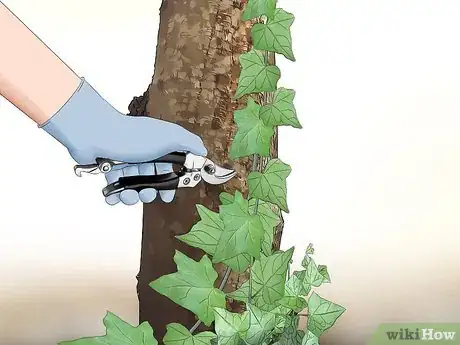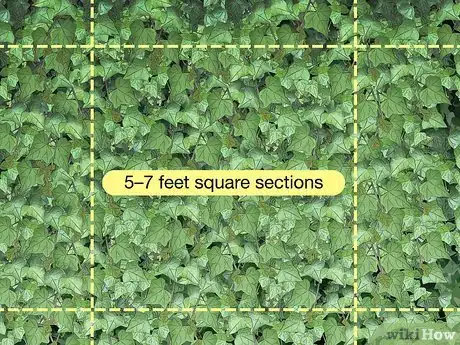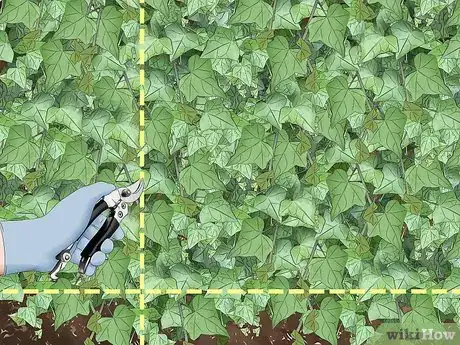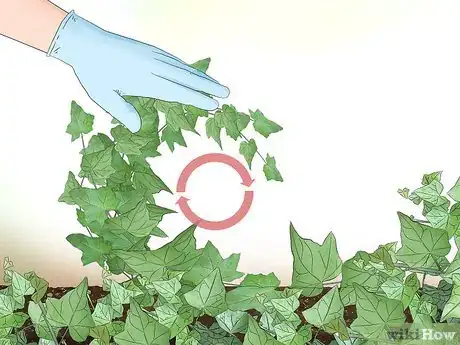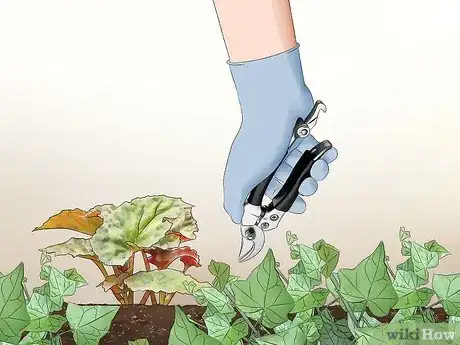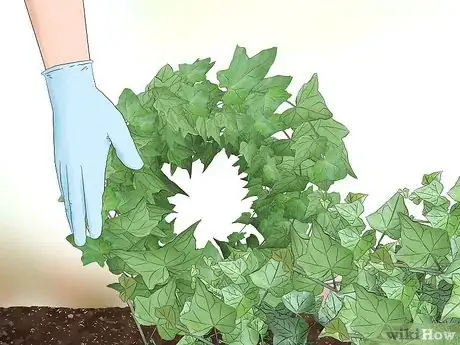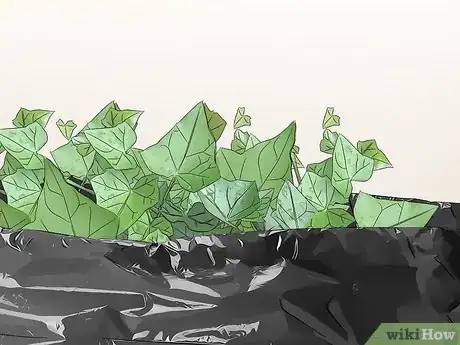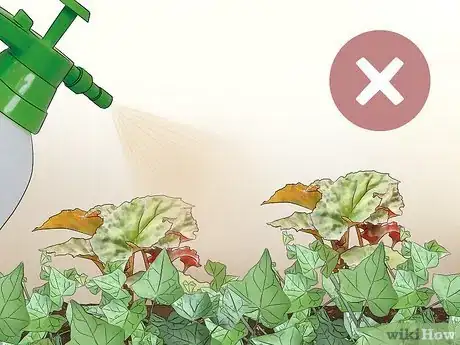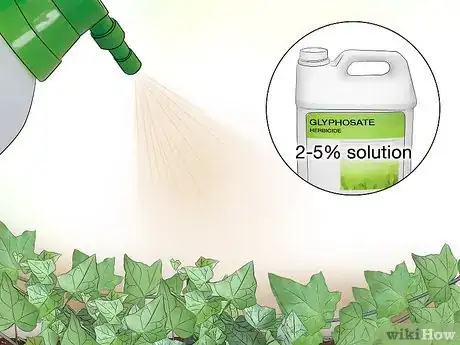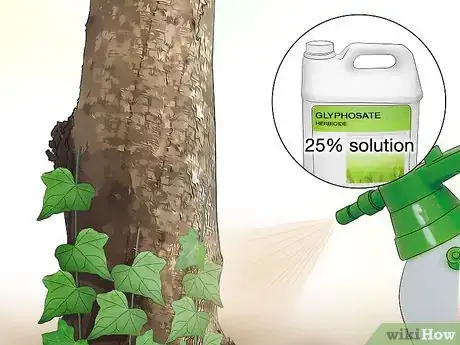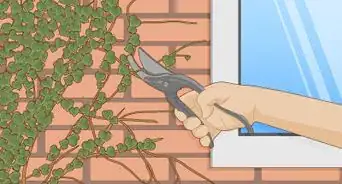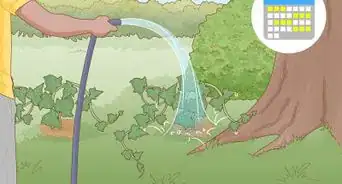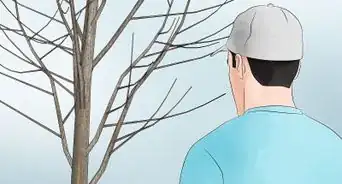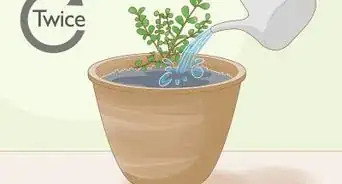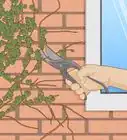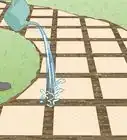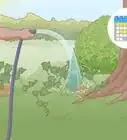This article was co-authored by Grant Wallace. Grant Wallace is a Landscaper and Owner of Grantlanta Lawn in Atlanta, Georgia. With over seven years of experience, he specializes in lawn maintenance and landscape installation. In 2012, he earned his BA from the University of West Georgia. Grant has been profiled in Shoutout Atlanta, Canvas Rebel, and Voyage ATL.
There are 13 references cited in this article, which can be found at the bottom of the page.
This article has been viewed 8,889 times.
English ivy is a climbing vine and groundcover that was introduced to North America almost 300 years ago by colonists from Europe. Unfortunately, as with many plants not native to North America, English ivy has become difficult to control and eradicate. Many provinces, states, and cities consider English ivy an invasive species that, in some cases, must be removed by residents. In areas where English ivy is allowed, gardeners may find it growing out of control and ruining or killing their other plants. The ‘lifesaver’ method of ivy removal can be used anywhere that the ivy is growing up a tree. The ‘log’ method can be used anywhere that the ivy is only growing on the ground. Herbicides can be used in any situation, although they should be considered a last resort.[1]
Steps
Using the Lifesaver Method
-
1Use clippers to cut all vines at the base of the tree. One of the most successful methods of controlling English ivy is the ‘lifesaver’ method which removes all the ivy from the lower 4–5 feet (1.2–1.5 m) of the tree and a 3–6 feet (0.91–1.83 m) radius around the tree. Start by using your garden shears or clippers and cut all the English ivy vines around the base of the tree, as close to the ground you can get.[2]
- Depending on the size of the vines, you may need to use loppers or even a small saw instead of garden shears/clippers.
- This method is called ‘lifesaver’ in reference to lifesaver candy, where the ground cleared around the tree is saving the life of the tree and the tree itself represents the hole in the candy.
-
2Cut a second circle around the tree at shoulder-level. Stand beside the tree and select a location on the trunk that’s at shoulder or eye height. Use your garden shears/clippers to cut a second circle through the English ivy around the trunk of the tree.[3]
- If the ivy has been growing for a long time, you may need loppers or a small saw to cut through the vines.
Advertisement -
3Rip away all pieces of ivy between 2 cuts you made around the tree. Use gloved hands to slowly pull away all the English ivy vines that are stuck to the tree between the 2 circle cuts you made. Pull each vine away from the tree carefully, as some of the vines may be intertwined. Cut the ivy as needed to untangle the vines.[4]
- Be very careful that you don’t rip the bark off the tree while removing the ivy vines.
- Throw the vines you remove into a single pile to dispose of later.
-
4Cut a circle 3–6 feet (0.91–1.83 m) out from the base of the tree. Step away from the tree by 3–6 feet (0.91–1.83 m). Use your garden shears/clippers to cut a circle through the English ivy growing on the ground around the entire tree. You may need to adjust the distance from the tree depending on any obstacles that are in your way (e.g., fences, walkways, other plants, etc.).[5]
- Make sure you cut through the entire thickness of the ivy that’s lying on the ground.
-
5Make several radiating cuts out from the base of the tree. To make removal a little easier, cut more than 1 line through the English ivy from the base of the tree to the larger circle cut on the ground. These radiating cuts will divide the ivy on the ground into several smaller sections which can be removed individually.[6]
- Cut as many or as few of these radiating line cuts as needed.
-
6Remove all ivy vines and roots from each section on the ground. Use your hands to pull away all the English ivy vines laying on the ground within each section. Make sure you pull all the roots out of the soil as you go. Cut through additional vines as needed.[7]
- Be careful when pulling up the vines if there are any plants you want to keep growing through the ivy.
- Continue to put the removed ivy vines into a pile for disposal.
-
7Dispose of removed ivy in the trash or by burning it. Do not put the English ivy vines that you’ve removed into your home compost. English ivy is very hardy and can regrow from only a small portion of root or stem. Put the removed ivy into the trash or curbside yard waste pick-up.[8]
- Alternatively, you can burn the removed ivy vines if you prefer and if you have the appropriate space for such burning.
-
8Check the cleared area regularly and remove sprouting ivy. At least once a week for the following 3-6 months, check the ground around the tree. Look for any English ivy that’s trying to regrow in that area and remove it immediately. If needed, cut back the vines that try to grow into the circle. Throw any ivy removed into the garbage.[9]
- Do not attempt to pull down the dead ivy vines that are still in the tree or you might damage the tree.
- After several months, the vines left in the tree will die and the leaves will turn brown and fall off.
- Eventually, the ivy won’t be as visible from below as the tree continues to grow.
Rolling Ivy Vines into Logs
-
1Select a square area where you want to remove the ivy. The ‘log’ method is designed for English ivy that’s covering a large area of ground. Start the removal process by mentally dividing that area into smaller 5–7 feet (1.5–2.1 m) square sections. Start with one small square and work your way systematically through the rest of the squares.[10]
- It is not necessary to be precise about the size of the squares.
- The ‘log’ method can be done successfully by 1 person but is easier to do with at least 2 people.
-
2Use garden shears/clippers to cut a square perimeter in the ivy. Starting with the first square, use your garden shears/clippers to cut a perimeter around the square you want to remove. Make sure you cut through the full thickness of the ivy, right to the soil.[11]
- You may need to use loppers or a saw in order to cut through some of the thicker ivy vines.
-
3Lift the ivy vines off the ground from one side. Pick one side of the square from which to start. If the area is sloped, start with the side of the square that’s at the top of the slope so you can roll the ivy downhill. Use your gloved hands to pick up the English ivy along that side of the square and pull it away from the ground. Make sure you remove all the roots from the soil.[12]
- Imagine the ivy lying on the ground within your square as a carpet. Starting with one side of the ‘carpet,’ you’re going to roll it into a log-type shape.
-
4Pull ivy roots from the ground while rolling vines into a log. Continue to pull the English ivy off the ground and fold it over onto itself so you can roll it into a log-type shape. Go slowly so you can make sure all the roots have been removed from the soil. Use your garden shears/clippers if needed to loosen or untangle the vines.[13]
- Try your best not to leave any roots behind. English ivy can regrow from very small pieces of roots or stems.
-
5Cut the ivy from around native plants to prevent damage to them. Hopefully, the area from which you’re removing the English ivy is void of any other plants. However, if there are native plants growing through the ivy, be very careful not to disturb or remove them. Use your garden shears/clippers to cut the ivy around the native plant so you can pull away the ivy without pulling out the native plant.[14]
- Check your provincial or state government websites to determine which plants are native to your area.
- There may be rules or regulations in your area that make it illegal to remove certain native plants.
-
6Keep rolling the vines until the complete square is removed. Either alone or with a partner, continue to pull the English ivy off the ground and to roll it into a log-type shape. If you’re working on a slope, allow gravity to help you roll the ivy downhill. Keep rolling until you’ve pulled all the ivy from the square you cut earlier.[15]
- Note that the roots of English ivy are fairly shallow, growing only 1–4 in (2.5–10.2 cm) into the soil.
- Try to disturb the soil as little as possible. This includes walking on it after you’ve removed the ivy.
-
7Dispose of the ivy log in the garbage or by mulching it. Do not put the removed English ivy into your home compost. Either put it in the trash or have it picked up as yard waste. If you’ve cleared a massive area and regular disposal methods are not possible, you can mulch the ivy logs and spread the cut pieces onto the soil.[16]
- Home compost systems do not get hot enough to completely kill the organic material inside. Therefore, when you use compost from your home system, you may accidentally transfer ivy plants into your garden.
- Mulch the ivy logs by cutting through them with loppers until only tiny pieces remain or by putting them through a wood chipper or running over it with a lawnmower.
- There is a small chance that mulched ivy will regrow. However, this may be the easiest method of disposing of ivy logs when controlling a really large area of land.
Controlling Ivy with Chemicals
-
1Avoid spraying areas where native plants are growing with the ivy. Herbicides are not selective. When you spray herbicides onto an area, they will kill any and all plants in that area, including native plants. If there are native plants in the same location as the English ivy you want to control, you should use a non-chemical control method instead.[17]
- Check your provincial or state government website to identify which plants are native to your area.
- Be aware that some provinces or states consider it illegal to remove or disturb native plants.
-
2Apply 2-5% solution of glyphosate or triclopyr to the leaves of the ivy. Purchase either glyphosate or triclopyr from a local garden centre or hardware store. Follow the manufacturer’s instructions to mix a 2-5% solution of either chemical. Ensure the outside temperature is at least 12 °C (54 °F) and clear on both the day you spray and the following day. Use a handheld sprayer to apply that solution onto the English ivy. Spray enough so that the ivy leaves are wet, but not dripping with chemicals.[18]
- Please note: The WHO considers glyphosate to be a probable human carcinogen. Its use is prohibited in some states and countries. Please check with your local laws and use caution if handling this chemical.
- English ivy leaves have a waxy texture to them, which can make it difficult for the herbicides to soak into and kill the plant.
- It is best to spray herbicides in the late fall or early winter.
-
3Spray 25% glyphosate or 2% 2,4-D to newly cut ivy vines and stems. Buy glyphosate or 2,4-D herbicides from a garden centre or hardware store. Follow the manufacturer’s instructions to mix either a 25% solution of glyphosate or a 2% solution of 2,4-D. Use your garden shears/clippers to remove as many English ivy leaves as possible and cut through the vines of the ivy. Use a handheld sprayer to apply the herbicides onto the cut ivy, making sure to concentrate your spray on the raw ends of the stems and vines.[19]
- Before using any herbicides, check with your local government to determine if either glyphosate or 2,4-D are illegal where you live.
- Make sure it’s at least 12 °C (54 °F) and clear on the day you spray the herbicide and the following day.
-
4Monitor the sprayed area once a month and remove new growth. English ivy is very durable, hence why it’s considered invasive. Using herbicides is still not a guarantee that the ivy will be completely controlled. Throughout the year following herbicide application, monitor the ivy that’s been sprayed. If any specific areas are not dying off, spray additional herbicides onto those areas.[20]
- You do not need to remove the dead ivy if you don’t want to.
- You will not likely be able to grow anything successfully in the area where herbicides were sprayed.
- You may need to repeat this entire process if you’re not able to completely control the ivy after 1 application.
Expert Q&A
-
QuestionHow do I permanently kill English ivy without chemicals?
 Grant WallaceGrant Wallace is a Landscaper and Owner of Grantlanta Lawn in Atlanta, Georgia. With over seven years of experience, he specializes in lawn maintenance and landscape installation. In 2012, he earned his BA from the University of West Georgia. Grant has been profiled in Shoutout Atlanta, Canvas Rebel, and Voyage ATL.
Grant WallaceGrant Wallace is a Landscaper and Owner of Grantlanta Lawn in Atlanta, Georgia. With over seven years of experience, he specializes in lawn maintenance and landscape installation. In 2012, he earned his BA from the University of West Georgia. Grant has been profiled in Shoutout Atlanta, Canvas Rebel, and Voyage ATL.
Landscaper Your best bet is using whatever tool you have on hand to dig it up by the root. If the ivy is just in one little area, hand-pulling it might be a good choice. Using a weed-eater is another option.
Your best bet is using whatever tool you have on hand to dig it up by the root. If the ivy is just in one little area, hand-pulling it might be a good choice. Using a weed-eater is another option.
Warnings
- If exposed to the chemicals, follow the first aid instructions that come with the chemicals for treatment. If treatment doesn’t work, go to your local emergency room for medical intervention.⧼thumbs_response⧽
- Always follow the manufacturer’s instructions on how to apply chemicals safely.[21]⧼thumbs_response⧽
Things You’ll Need
Using the Lifesaver Method
- Clippers or loppers
- Gloves
- Long pants and a long-sleeve shirt
- Closed-toe shoes or boots
Rolling Ivy Vines into Logs
- Clippers or loppers
- Gloves
- Long pants and a long-sleeve shirt
- Closed-toe shoes or boots
Controlling Ivy with Chemicals
- Gloves
- Eye protection
- Breathing protection
- Glyphosate
- Triclopyr
- 2,4-D
Expert Interview
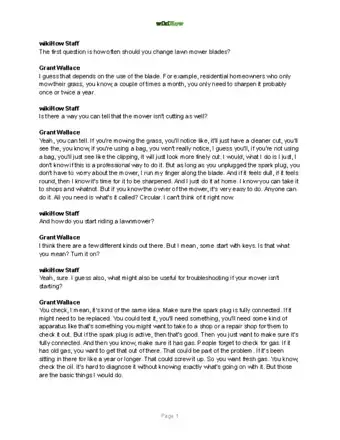
Thanks for reading our article! If you'd like to learn more about English ivy, check out our in-depth interview with Grant Wallace.
References
- ↑ https://your.kingcounty.gov/dnrp/library/water-and-land/weeds/Brochures/English-Ivy-fact-sheet.pdf
- ↑ https://extension.tennessee.edu/publications/Documents/W231.pdf
- ↑ https://www.portlandoregon.gov/parks/article/201781#methods
- ↑ https://extension.tennessee.edu/publications/Documents/W231.pdf
- ↑ https://www.hortmag.com/weekly-tips/pests-diseases/how-to-get-rid-of-english-ivy-in-the-landscape
- ↑ http://www.cmnmaps.ca/shim/atlases/invasivespecies/_private/englishivy.htm
- ↑ https://www.oregon.gov/ODA/programs/Weeds/Meetings/Documents/English%20Ivy%20Forum%202016/EnglishIvyManagementResourcePacket.pdf
- ↑ https://www.nwcb.wa.gov/images/weeds/english-ivy-control_King.pdf
- ↑ https://www.oregon.gov/ODA/programs/Weeds/Meetings/Documents/English%20Ivy%20Forum%202016/EnglishIvyManagementResourcePacket.pdf
- ↑ https://www.hortmag.com/weekly-tips/pests-diseases/how-to-get-rid-of-english-ivy-in-the-landscape
- ↑ https://www.portlandoregon.gov/parks/article/201781#methods
- ↑ https://www.nwcb.wa.gov/images/weeds/English-Ivy-brochure-2014_sanjuan.pdf
- ↑ https://content.ces.ncsu.edu/controlling-english-ivy-in-urban-landscapes
- ↑ http://m.olympiawa.gov/~/media/Files/PublicWorks/Water-Resources/OlyWild/OlyWild-Ivy-Removal.pdf?la=en
- ↑ https://www.kingcounty.gov/services/environment/animals-and-plants/noxious-weeds/weed-identification/english-ivy.aspx
- ↑ http://m.olympiawa.gov/~/media/Files/PublicWorks/Water-Resources/OlyWild/OlyWild-Ivy-Removal.pdf?la=en
- ↑ https://www.oregon.gov/ODA/programs/Weeds/Meetings/Documents/English%20Ivy%20Forum%202016/EnglishIvyManagementResourcePacket.pdf
- ↑ https://www.oregon.gov/ODA/programs/Weeds/Meetings/Documents/English%20Ivy%20Forum%202016/EnglishIvyManagementResourcePacket.pdf
- ↑ https://www.oregon.gov/ODA/programs/Weeds/Meetings/Documents/English%20Ivy%20Forum%202016/EnglishIvyManagementResourcePacket.pdf
- ↑ https://wric.ucdavis.edu/information/natural%20areas/wr_H/Hedera_canariensis-helix-hibernica.pdf
- ↑ http://npic.orst.edu/factsheets/24Dgen.pdf

